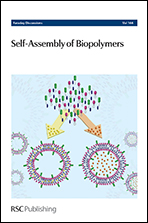Peptide nanofibres as molecular transporters: from self-assembly to in vivo degradation
Abstract
Peptide nanofibres (PNFs) have gained increasing interest as engineered biomaterials for drug delivery and tissue repair because of the versatility in design they offer through the self-assembly of amphiphilic peptide molecules. Their self-assembly is governed by hydrophobic interactions and hydrogen bonds between peptide sequences able to form β-sheets. In this report, we describe the self-assembly of PNFs by using palmitoyl-peptide molecules containing two different cationic amino acid sequences and offer a description of the nanofiber physicochemical characteristics. The structural degradation of these PNFs in physiologically-relevant media was evaluated experimentally and two mechanisms are proposed. We also piloted the tracking of PNFs intracellularly in vitro, upon interaction with primary neuronal cultures, and intracranially in vivo, after stereotactic administration deep within the brain using two types of fluorescent labelled PNFs. Overall, the self-assembled PNFs were seen to internalise within neurons and be removed or degrade in the brain. Further work is needed to determine the utility of such PNFs as molecular transporters within neuronal tissue.
- This article is part of the themed collection: Self-Assembly of Biopolymers

 Please wait while we load your content...
Please wait while we load your content...